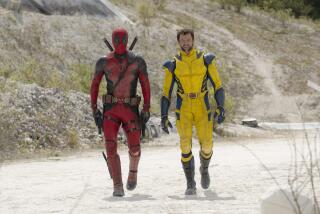Disney ends Anschutz flak as it drops ‘Narnia’
Totaled together, the first two “Chronicles of Narnia” films grossed nearly $1.2 billion around the world, making it one of the most successful box-office franchises in recent years. So why would Disney, which co-financed and co-produced the films with Phil Anschutz’s Walden Media, walk away from such a valuable property? The back story is messy, involving an ugly dispute between Disney and Anschutz, a true battle of the titans.
The obvious reason for Disney to pull out was that, compared with the astounding success of the first film, 2005’s “The Lion, the Witch and the Wardrobe,” which amassed nearly $750 million in global business, the second film in the series, 2008’s “Prince Caspian,” was a big disappointment, grossing roughly $420 million. Still, $420 million is nothing to sneeze at, being way more money than any Disney film, except “Wall-E,” made all year.
But it turns out that “Prince Caspian” didn’t just bring in less money; it also cost more to make and market -- a lot more. Disney acknowledges that the film cost roughly $225 million, with nearly $100 million of that going for the film’s elaborate special effects. Even worse, because the studio was trying to expand the series’ audience by going after teen moviegoers as well as families, Disney overspent on marketing, with some insiders estimating that the studio spent as much as $175 million on worldwide marketing for the film.
But what really derailed Disney’s involvement with “Narnia” was a nasty feud between the studio and Anschutz, the real-estate baron and supporter of Christian conservative causes who seems to own half of America. Anschutz has a stake in or outright ownership of Regal Entertainment Group (the nation’s biggest movie theater chain), Staples Center, the Kodak Theatre, the Los Angeles Galaxy, the L.A. Kings, London’s Millennium Dome, a string of U.S. newspapers (including the San Francisco Examiner) and Walden Media, which has produced such films as “Journey to the Center of the Earth,” “Nim’s Island” and “Because of Winn-Dixie.”
According to multiple sources, the once-close relationship between Disney and Walden began to unravel when, after the first “Narnia” film cleaned up at the box office, Anschutz essentially put a gun to Disney’s head and demanded that the studio renegotiate its deal with Walden. Anschutz insisted that Disney either give back a sizable chunk of the studio’s lucrative distribution fee or Anschutz would distribute the “Narnia” series on his own. Believing the franchise was too good to give up, Disney reluctantly changed the terms of its Walden deal, but the renegotiation poisoned relations between the two behemoths. When the second film faltered, there was so little goodwill left over that Disney had far fewer qualms about cutting its ties with the franchise.
To be fair, Walden wasn’t all that happy with the way Disney handled the film. The first movie had been released at Christmas, which seemed a logical slot for a family-oriented picture. But when Disney saw that “Prince Caspian” was an edgier, more youth-oriented film, it decided to go after teenagers as well as family filmgoers. That decision led to what, in hindsight, appears to be a huge blunder, releasing “Prince Caspian” in May, at the start of summer. Sandwiched between “Iron Man” and “Indiana Jones and the Kingdom of the Crystal Skull,” “Prince Caspian” not only failed to attract many teenagers, it also lost a large piece of its family following, which was turned off by the edgier, not especially well-focused marketing materials.
“We felt that, for that film, we had to try to appeal to every audience,” says Disney studio chief Dick Cook. “The movie was edgier and tougher, and the marketing materials reflected that. Sometimes when you do that, you risk alienating the families, and maybe that’s what happened.” Cook defended the studio’s decision to open the movie in the summer. “Warners has always been able to move ‘Harry Potter’ back and forth, so we thought we had just as good a chance of doing well. Honestly, who knows -- it may have been a factor. In the summertime, you don’t always get many second chances. But release dates are funny -- they never seem to affect a movie people really want to see.”
Walden is moving ahead with plans to make a third film in the series, “The Voyage of the Dawn Treader,” which will have a new director, Michael Apted, but also much of the cast, including Ben Barnes (Prince Caspian), from the previous films. The story is said to be far more commercial than the last installment, being more of a classic boy’s seagoing adventure story, complete with fantastic sights, dragons, wizards and sea serpents, not to mention Eustace Scrubb, who I hear on good authority is one of the most inspired rotten kids in English literature. The real fascinating question is: Who will release it? Walden could announce a new deal as early as later this week.
It doesn’t have a lack of suitors. The studio with the inside track is 20th Century Fox, which has first dibs on the project because it already markets and distributes Walden projects under its Fox-Walden banner. Fox has plenty of interest, having seriously considered acquiring the movie rights to the C.S. Lewis books before Walden landed them. Fox has a strong marketing department, with lot of success with family entertainment -- the studio’s biggest hits last year were both family films: “Horton Hears a Who” and the year-ending “Marley & Me.”
But Fox is famous for driving hard bargains and exercising fiscal discipline, so don’t expect to see “Dawn Treader” costing anywhere near $225 million. Walden has been aiming to bring the new film in at around $140 million, which would be a far more enticing price tag for a 50/50 studio partner. If Fox passes, both Sony and Warners have expressed strong interest in the project. It would be a good fit for either studio, giving Sony something it hasn’t had in recent years -- a fantasy-oriented family franchise -- or providing Warners with a ready-made family-oriented franchise to replace the soon-to-be-completed “Harry Potter” series. Whatever happens, it seems likely that the franchise’s fans will soon have another chance to visit the enchanted world of Narnia and other distant lands.
--
patrick.goldstein @latimes.com
More to Read
The biggest entertainment stories
Get our big stories about Hollywood, film, television, music, arts, culture and more right in your inbox as soon as they publish.
You may occasionally receive promotional content from the Los Angeles Times.










